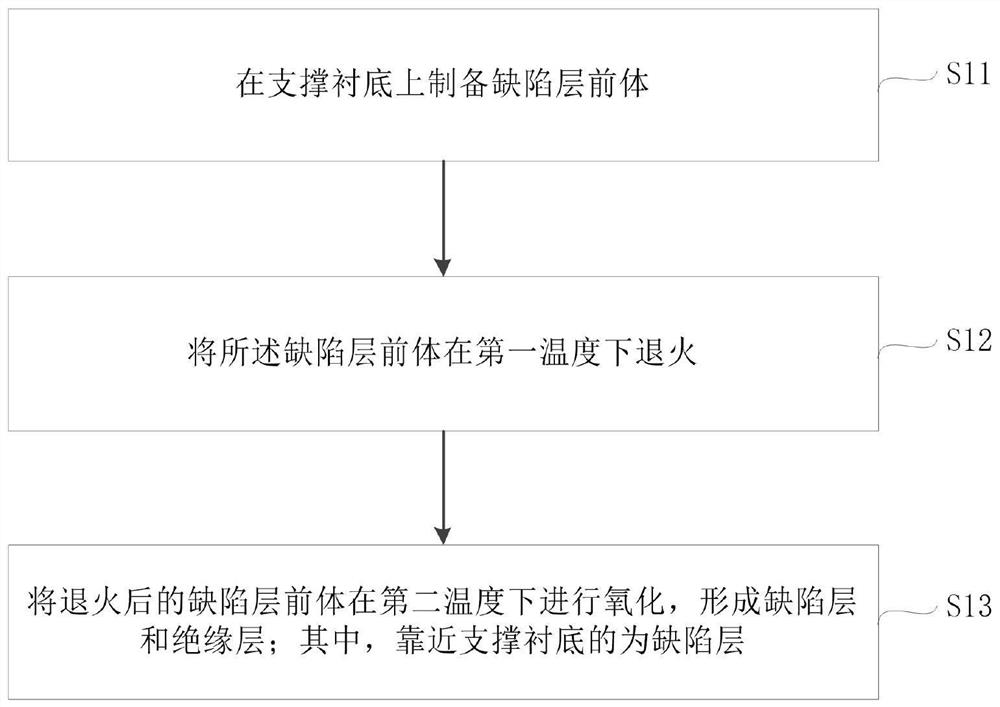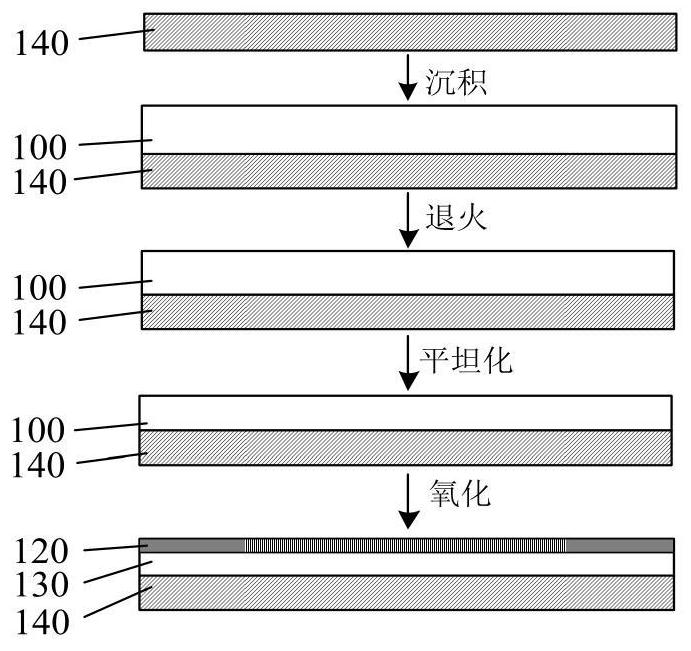Preparation method of composite substrate, composite film and electronic component
A composite substrate and composite film technology, which is applied in the manufacturing of electrical components, piezoelectric devices/electrostrictive devices, semiconductor/solid-state devices, etc. Rough interface, increased substrate dielectric loss, etc.
- Summary
- Abstract
- Description
- Claims
- Application Information
AI Technical Summary
Problems solved by technology
Method used
Image
Examples
preparation example Construction
[0039] Specifically, refer to figure 2 , the preparation method comprises:
[0040] S11 , preparing a defect layer precursor 100 on the supporting substrate 140 .
[0041] Optionally, the preparation method of the defect layer precursor 100 is LPCVD or PECVD, and its thickness may be 200nm-20um, as long as it can realize the support function, which is not specifically limited.
[0042] Wherein, the LPCVD or PECVD is an existing method, for details, reference may be made to the implementation of an existing method, and no further description is given here.
[0043] S12, annealing the defect layer precursor 100 at a first temperature.
[0044] Optionally, in this step, the support substrate 140 containing the defect layer precursor 100 obtained in step S11 is placed in a high-temperature annealing furnace, and nitrogen annealing is performed at 900° C. to 1100° C. (first temperature), and the annealing time is 3h~24h.
[0045] Before the annealing, the wafer prepared in ste...
Embodiment 1
[0083] 1) A Si single wafer is selected as the support substrate, and a polysilicon layer with a thickness of 1.8um is grown on the support substrate by LPCVD as a defect layer precursor, and then the surface of the polysilicon layer is cleaned.
[0084] 2) Place the supporting substrate with the polysilicon layer in step 1) for annealing in a high-temperature annealing furnace, the annealing temperature is 1000°C, the annealing time is 8h, and it is cleaned.
[0085] 3) Perform thermal oxidation treatment on the annealed and cleaned polysilicon layer in step 2), the thermal oxidation temperature is 900°C, and the thermal oxidation time is 10h, and the part of the polysilicon layer far away from the supporting substrate is oxidized into silicon dioxide (insulating layer) , the part of the polysilicon close to the supporting substrate is not oxidized to form a defect layer. The surface of the silicon dioxide layer is planarized, and the planarized silicon dioxide surface is cle...
Embodiment 2
[0089] 1) A Si single wafer is selected as the support substrate, and a polysilicon layer with a thickness of 1.8um is grown on the support substrate by LPCVD as a defect layer precursor, and then the surface of the polysilicon layer is cleaned.
[0090] 2) Place the supporting substrate with the polysilicon layer in step 1) for annealing in a high-temperature annealing furnace, the annealing temperature is 1000°C, the annealing time is 8h, and it is cleaned.
[0091] 3) Polishing the annealed polysilicon layer in step 2), removing a thickness of 300 nm, and cleaning the surface of the polished polysilicon layer again.
[0092] 4) Perform thermal oxidation treatment on the polished and cleaned polysilicon layer in step 3), the thermal oxidation temperature is 900°C, the thermal oxidation time is 10h, and the part of the polysilicon layer far away from the supporting substrate is oxidized into silicon dioxide (insulating layer) , the part of the polysilicon close to the support...
PUM
| Property | Measurement | Unit |
|---|---|---|
| Thickness | aaaaa | aaaaa |
| Thickness | aaaaa | aaaaa |
| Thickness | aaaaa | aaaaa |
Abstract
Description
Claims
Application Information
 Login to View More
Login to View More - R&D
- Intellectual Property
- Life Sciences
- Materials
- Tech Scout
- Unparalleled Data Quality
- Higher Quality Content
- 60% Fewer Hallucinations
Browse by: Latest US Patents, China's latest patents, Technical Efficacy Thesaurus, Application Domain, Technology Topic, Popular Technical Reports.
© 2025 PatSnap. All rights reserved.Legal|Privacy policy|Modern Slavery Act Transparency Statement|Sitemap|About US| Contact US: help@patsnap.com



